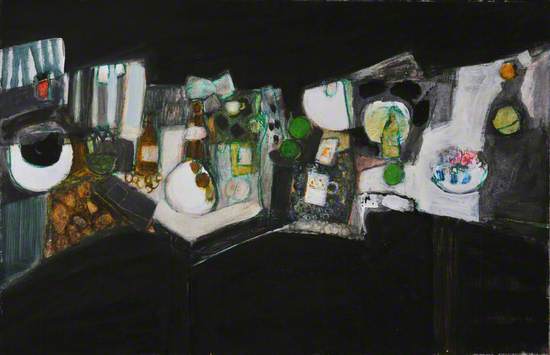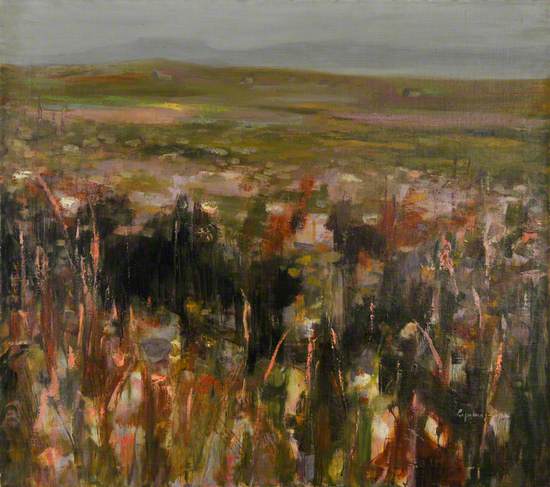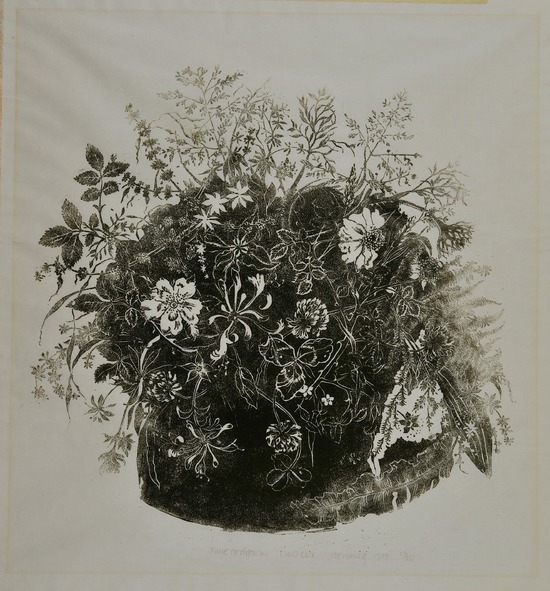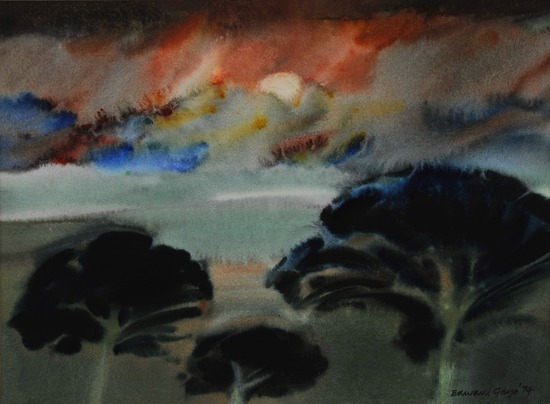Awaken was an exhibition curated by Lily Vaughan from The Argyll Collection - an astounding collection cared for by Argyll & Bute Council. From January - April 2024, Lily worked as Exhibition Trainee with Culture Heritage & Arts Assembly Argyll & Isles (CHARTS).
Through sight, touch, smell, taste, and sound, Lily aimed to 'awaken' visitors senses and enable them to experience The Argyll Collection differently.
The Argyll Collection was established in 1960 by author Naomi Mitchison, and Argyll & Bute County Council Art Advisor Jim Tyre. This incredible initiative is now the focus of Reconnected, a CHARTS led project aiming to review the importance of the collection and make recommendations for an impactful future.
Still Life with Cup and Saucer
To this day, Donaldson is considered a leading portrait painter. In this painting, Donaldson has chosen to paint himself (reflected in the mirror) in a sad setting. This sadness is communicated through the blue paint applied in downward-facing strokes. Take a look at the cup. Does it reflect his feelings, a glass half empty? It’s a very contemplative artwork - what do you think he is trying to express?
David Donaldson taught Jim Tyre at Glasgow School of Art and the two remained close friends.
David Abercrombie Donaldson (1916–1996)
Oil on canvas
H 76.3 x W 63.5 cm
Argyll and Bute Council
The Cheerful Troubadour
Troubadours travelled around Europe reciting poems, playing instruments, and singing about love. Robb explores their playfulness through the bright oranges and reds (the colour of love). This fun theme is continued through Robb’s lines and block colours, which give a cartoon-like appearance. Look at the troubadour, he is belting out his lyrics. Look at the bodies of the horse and troubadour, intertwining. I can imagine the horse’s hooves thudding against the dusty ground whilst the troubadour tunes his lute to the beat of the trot.
What can you hear?
Brian Robb (1913–1979)
Oil on canvas
H 25.5 x W 77.5 cm
Argyll and Bute Council
Sleck Cow
The wide neck and narrow hips of this animal tell us straight away that it is a cow. Can you remember ever seeing a cow? What were you doing at the time? What senses does your memory provoke? For me, it is the memory of paddling in the chilly Clyde at Toward beach with sand-infused egg sandwiches! The fields revealed curious faces peering over to say hello. Does this sound familiar to you?
Four Heads
Jade is a very interesting material. Known to symbolise wealth and nobility, it is nearly indestructible, and stays cool to the touch. Maybe this four-headed creature is a powerful figure? Or perhaps the four heads represent different emotions or personalities? During my research, I was unable to find any figures with four heads. Maybe this is a reflective piece for the artist? Do you ever feel like you have multiple sides to your personality? Jade is often seen as a grounding stone. How does it make you feel?
Party Table
McIntosh is one of the few artists represented in the Argyll Collection who is still alive. He continues painting in the semi-abstracted style we see here. What has happened in this painting? The black background doesn’t tell us what kind of party it has been. This sense of the unknown continues through the shapes. McIntosh has represented a 3D scene in a 2D way. Maybe this is because the party felt kind of flat? This idea is supported by large amounts of beer.
What other food and drink items can you see?
Archibald Dunbar McIntosh (b.1936)
Oil, crayon & acrylic (?) on hardboard
H 76 x W 116.5 cm
Argyll and Bute Council
Eoligarry VI
This painting, which is set in Barra, is a very sense provoking image. Pope would immerse herself in her subjects to capture the feelings surrounding them. I am unsure if Pope worked on location or relied upon smaller studies before producing the final piece. The flurry of flowers fill the air with sweet scents, as the freshness from the fog comes tumbling down the hills under the heavy sky. The emptiness behind the field features small forms, perhaps cottages or sheep? Where does this painting make you think of?
Perpetua Pope (1916–2013)
Oil on canvas
H 92.8 x W 105.2 cm
Argyll and Bute Council
In this piece, the fuzzy reflections upon the water give the image a sense of movement. Parker has achieved a fluid appearance in a traditionally very graphic media. Impressively, she has created something very striking and realistic with only a very limited colour palette of whites, greys, blacks and greens. You can almost smell that soft, sweet, lily scent oozing through the frame!
Parker’s two artworks in The Argyll Collection were gifts to Naomi Mitchison from the artist herself, the two were close friends.
Agnes Miller Parker (1895–1980)
Wood engraving
H 12.7 x W 10.2 cm
Argyll and Bute Council
Velvet Cherries is an interesting title, could it be a play on words? Is Cowie suggesting that the cherries have a velvety texture in your mouth? How would you describe the sensation of eating a cherry?
Cowie’s subtle use of colour also impacts on our experience of the work. The very dark red, almost burgundy colour of the cherries, gives them a plump and juicy appearance against the flatter, cold black background. The artwork was created using glue, embroidery and applique. These are interesting to look out for.
Caroline Hemming began illustrating whilst staying with a friend whose gardens inspired her artworks. Her work is very realistic. Can you name any of the plants? Can you smell the earthy soil and the aromatic flowers?
Hemming has created a lot of fine detail - not an easy task in linocuts. Adegraph (used in printmaking) is a rubbery material that you cut into using V-shaped tools which are tricky to direct in different directions, making curves and circular shapes hard to achieve.
Jennifer Hex created Waterfall, Mull during her artists’ residency in islands schools around Argyll. Mull has an abundance of waterfalls, the most famous of which is Eas Fors (translated as waterfall waterfall waterfall in Gaelic). In her depiction of this waterfall, Hex successfully captures the fluidity of water through organic lines. The embroidery is not rigid, it splays out, just as water does. She explores this further through the bubbly stitches at the bottom which suggest foaming and splashing.
Jennifer Hex (1938–2016)
Embroidery
H 112 x W 58 cm
Argyll and Bute Council
The stormy and destructive atmosphere gives this painting a sense of danger and excitement! Can you smell the salty sea air? Although the perspective is not as you would expect, with the middle appearing flat - Gage brings the artwork to life through his use of colour and painterly techniques. The bleeding of the watercolour paint makes the trees appear as though they are trembling! It creates a slashing effect in the sea and makes the sky look like it is breaking apart to reveal the sun.
Edward Arthur Gage (1925–2000)
Watercolour
H 30.5 x W 40.6 cm
Argyll and Bute Council
Edward Gage was the father of local Argyll-based artist Anthea Gage. Pale Moon Carpet is interesting because Gage chose to focus more on colour and pattern, rather than perspective. If we look closely at the carpet, we can see that Gage has created texture by layering multiple patterns. The nude figure seems to stroke the fabric. Perhaps Gage wants us to consider the feeling of textured designs on our skin?
Edward Arthur Gage (1925–2000)
Oil & acrylic (?) on canvas
H 71.5 x W 91.9 cm
Argyll and Bute Council
Explore artists in this Curation
View all 11-
 David Abercrombie Donaldson (1916–1996)
David Abercrombie Donaldson (1916–1996) -
 Natak
Natak -
 Jennifer Hex (1938–2016)
Jennifer Hex (1938–2016) -
 Brian Robb (1913–1979)
Brian Robb (1913–1979) -
 Archibald Dunbar McIntosh (b.1936)
Archibald Dunbar McIntosh (b.1936) -
 Kathleen Finlay Horsman (1911–1998)
Kathleen Finlay Horsman (1911–1998) -
 Bel Cowie (1943–1983)
Bel Cowie (1943–1983) -
 Agnes Miller Parker (1895–1980)
Agnes Miller Parker (1895–1980) -
 Caroline Hemming (1931–2017)
Caroline Hemming (1931–2017) -
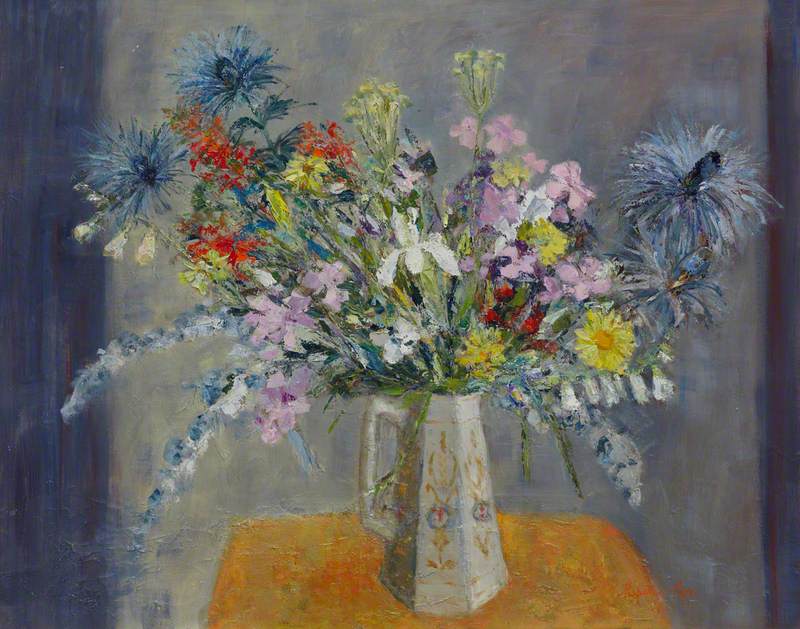 Perpetua Pope (1916–2013)
Perpetua Pope (1916–2013) - View all 11




